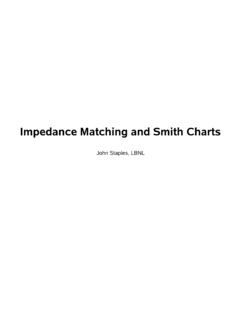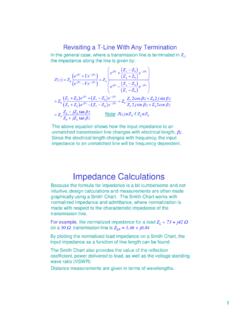Transcription of 422 and 485 Overview and System Configurations
1 Application Report SLLA070D June 2002 Revised May 2010. RS-422 and RS-485 Standards Overview and System Configurations Manny Soltero, Jing Zhang, and Chris Cockril .. HPA - Industrial Interface Updated by Kevin Zhang, Clark Kinnaird, and Thomas Kugelstadt .. ABSTRACT. ANSI TIA/EIA-422 and TIA/EIA-485 standards, commonly known as RS-422 and RS-485, respectively, specify balanced data-transmission schemes for transmitting data over long distances in noisy environments. These standards are compared, and their basic differences and similarities are discussed. Techniques for impedance matching to minimize line reflections in several applications are presented, with laboratory test results.
2 Contents 1 Introduction .. 3. 2 Overview of RS-422 and RS-485 Standards .. 3. Selected RS-422 Electrical Specifications .. 3. Selected RS-485 Electrical Specifications .. 9. 3 Failsafe Operation .. 12. The Need for Failsafe Protection .. 12. Internal Failsafe .. 13. External Failsafe .. 13. 4 Suggested Termination and Grounding Techniques .. 13. No Termination .. 13. Parallel Termination .. 14. AC Termination .. 16. Multipoint Termination .. 17. Ground Connections .. 18. 5 Typical System Configurations .. 21. Daisy-Chain Configuration .. 21. Bus and stub Configuration .. 21. Point-to-Point Configuration.
3 22. 6 Summary Comparison of the Standards .. 22. Common-Mode Range .. 22. Line Contention .. 23. Drive Current .. 23. 7 Conclusion .. 23. 8 Glossary .. 24. 9 Acknowledgment .. 24. 10 References .. 24. List of Figures 1 RS-422 Balanced-Voltage Digital-Interface Circuit .. 4. 2 RS-422 Open-Circuit Test Circuit .. 4. 3 RS-422 Output-Voltage Test Circuit .. 5. 4 RS-422 Short-Circuit Output-Current Test Circuit .. 5. 5 RS-422 Power-Off Output-Current Test Circuit .. 5. 6 RS-422 Test Circuit and Output-Signal Waveform .. 6. SLLA070D June 2002 Revised May 2010 RS-422 and RS-485 Standards Overview and System Configurations 1.
4 Copyright 2002 2010, Texas Instruments Incorporated 7 RS-422 Input Receiver Test Circuit and I/V Plot .. 7. 8 RS-422 Input-Sensitivity Test Circuit and Resultant Waveform .. 8. 9 RS-485 Balanced-Voltage Digital-Interface Circuit .. 9. 10 RS-485 Test Circuit and I/V Relationship .. 10. 11 RS-485 Open-Circuit Test Circuit .. 10. 12 RS-485 Output-Voltage Test Circuit .. 11. 13 RS-485 Output-Voltage Test Circuit With Common-Mode Loading .. 11. 14 RS-485 Short-Circuit Output-Current Test Circuit .. 11. 15 RS-485 Output-Signal Test Circuit .. 12. 16 Differential Unterminated Configuration .. 13. 17 Differential Unterminated-Driver Output Waveforms.
5 14. 18 Differential Unterminated-Receiver Input Waveforms .. 14. 19 Differential Parallel-Terminated Configuration .. 15. 20 Differential Parallel-Terminated Driver Output Waveforms .. 15. 21 Differential Parallel-Terminated Receiver Input Waveforms .. 16. 22 Differential AC-Terminated Configuration .. 16. 23 Differential AC-Terminated Driver Output Waveforms .. 17. 24 Differential AC-Terminated Receiver Input Waveforms .. 17. 25 Differential Multipoint-Terminated Configuration .. 18. 26 Grounding Configuration with Isolated Local Ground and PE .. 19. 27 Grounding Configuration with Connected Local Ground and PE.
6 19. 28 Isolated Configuration .. 20. 29 Daisy-Chain Connection .. 21. 30 stub Cables Connected to the Main Backbone .. 22. 31 Point-to-Point Connection .. 22. List of Tables 1 Input Sensitivity and Resultant Voltages of 422-Compliant Devices .. 8. 2 Input Sensitivity and Resultant Voltages of 485-Compliant Devices .. 12. 3 Summary of Termination 18. 4 Summary Comparison of RS-485 and RS-422 Specifications .. 23. 2 RS-422 and RS-485 Standards Overview and System Configurations SLLA070D June 2002 Revised May 2010. Copyright 2002 2010, Texas Instruments Incorporated Introduction 1 Introduction The RS-422 and RS-485 standards, as they are known today, are balanced data-transmission schemes that offer robust solutions for transmitting data over long distances and noisy environments.
7 The official titles for these two standards are ANSI TIA/EIA-422 and TIA/EIA-485, respectively, and are revised periodically by the DTE-DCE Interfaces and Protocols Subcommittee to the Telecommunications Industry Association (TIA) TR-30 Data Transmission Systems and Equipment Committee. For identification, RS-422 and RS-485 suffice. This application report offers an Overview of the RS-422 and RS-485 standards. While many specifications are described in the official ANSI documents, only the most prevalent are discussed in this application report. The purpose of this application report is to not duplicate the official documents, but to outline basic differences and similarities between the RS-422 and RS-485 standards.
8 Major specifications are described in detail and the two standards are compared. Because impedance matching is an important aspect of differential data transmission in minimizing line reflections due to transmission-line effects, techniques for terminating different System applications are presented. Also, typical System Configurations are taken into consideration for optimal application performance and cost constraints. 2 Overview of RS-422 and RS-485 Standards Officially, the RS-422 standard's title is Electrical Characteristics of Balanced Voltage Digital Interface Circuits, and is published by the ANSI Telecommunication Industry Association/Electronic Industries Association (TIA/EIA).
9 In the industry, the term RS-422 is commonly used rather than the official name, and this document does the same. RS-422 is specified as a simplex multidrop standard, which means only one driver and up to ten receivers can be attached to a bus. The RS-485 standard's title is Electrical Characteristics of Generators and Receivers for Use in Balanced Digital Multipoint Systems. RS-485 is commonly used, rather than its official title. If more than one driver is required, devices conforming to RS-485 are recommended. RS-485 specifications allow only one driver to send data at a time, and up to 32 unit loads ( ) can be placed on the bus.
10 The concept is described in this application report in the Selected RS-485 Electrical Specifications section. RS-422 and RS-485 initially might appear to be similar, but are distinct, and interchangeability is determined by the bus architecture. The RS-485 standard is written to be electrically compatible with RS-422. To illustrate their basic differences, a condensed description of each standard is presented in the following subsections. Selected RS-422 Electrical Specifications The balanced-voltage digital interface is shown in Figure 1. The driver (or generator) is labeled D, the receiver is labeled R, and the termination impedance is ZT.











